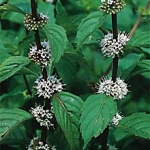
Vigorous, creeping, often purple-tinged, perennial with smooth, lanceolate, toothed leaves, to 8cm (3in) long. Lilac pink, sterile flowers are borne in oblong, terminal spikes. A hybrid between M. aquatica and M. spicata.
|
||||||||||
Peppermint tea, made from the plant’s leaves, is taken internally for a wide variety of ailments: stomach cramps, stomach pain, colic, flatulence, nausea, motion sickness, morning sickness, irritable bowel syndrome (IBS), fever, colds, and flu. It is probably most famed as a digestive aid. Menthol, peppermint’s primary ingredient, speeds digestion by stimulating the stomach lining. Food then moves more quickly out of the stomach, and indigestion is less likely to occur. Peppermint also relaxes digestive and stomach muscles. Externally, peppermint oil is used for respiratory ailments, coughs, sinus congestion, some skin conditions, and rheumatism. |
||||||||||
The Modern Herbal Primer by Nancy Burke Copyright©2000 Yankee Publishing, Inc. pp. 88-89 |


